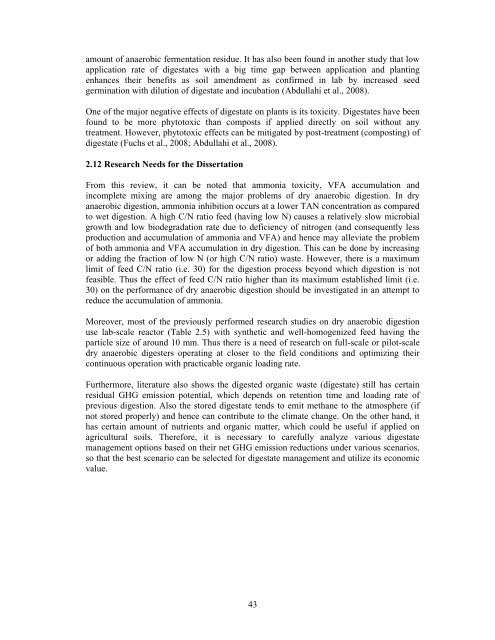dry anaerobic digestion of municipal solid waste and digestate ...
dry anaerobic digestion of municipal solid waste and digestate ...
dry anaerobic digestion of municipal solid waste and digestate ...
You also want an ePaper? Increase the reach of your titles
YUMPU automatically turns print PDFs into web optimized ePapers that Google loves.
amount <strong>of</strong> <strong>anaerobic</strong> fermentation residue. It has also been found in another study that low<br />
application rate <strong>of</strong> <strong>digestate</strong>s with a big time gap between application <strong>and</strong> planting<br />
enhances their benefits as soil amendment as confirmed in lab by increased seed<br />
germination with dilution <strong>of</strong> <strong>digestate</strong> <strong>and</strong> incubation (Abdullahi et al., 2008).<br />
One <strong>of</strong> the major negative effects <strong>of</strong> <strong>digestate</strong> on plants is its toxicity. Digestates have been<br />
found to be more phytotoxic than composts if applied directly on soil without any<br />
treatment. However, phytotoxic effects can be mitigated by post-treatment (composting) <strong>of</strong><br />
<strong>digestate</strong> (Fuchs et al., 2008; Abdullahi et al., 2008).<br />
2.12 Research Needs for the Dissertation<br />
From this review, it can be noted that ammonia toxicity, VFA accumulation <strong>and</strong><br />
incomplete mixing are among the major problems <strong>of</strong> <strong>dry</strong> <strong>anaerobic</strong> <strong>digestion</strong>. In <strong>dry</strong><br />
<strong>anaerobic</strong> <strong>digestion</strong>, ammonia inhibition occurs at a lower TAN concentration as compared<br />
to wet <strong>digestion</strong>. A high C/N ratio feed (having low N) causes a relatively slow microbial<br />
growth <strong>and</strong> low biodegradation rate due to deficiency <strong>of</strong> nitrogen (<strong>and</strong> consequently less<br />
production <strong>and</strong> accumulation <strong>of</strong> ammonia <strong>and</strong> VFA) <strong>and</strong> hence may alleviate the problem<br />
<strong>of</strong> both ammonia <strong>and</strong> VFA accumulation in <strong>dry</strong> <strong>digestion</strong>. This can be done by increasing<br />
or adding the fraction <strong>of</strong> low N (or high C/N ratio) <strong>waste</strong>. However, there is a maximum<br />
limit <strong>of</strong> feed C/N ratio (i.e. 30) for the <strong>digestion</strong> process beyond which <strong>digestion</strong> is not<br />
feasible. Thus the effect <strong>of</strong> feed C/N ratio higher than its maximum established limit (i.e.<br />
30) on the performance <strong>of</strong> <strong>dry</strong> <strong>anaerobic</strong> <strong>digestion</strong> should be investigated in an attempt to<br />
reduce the accumulation <strong>of</strong> ammonia.<br />
Moreover, most <strong>of</strong> the previously performed research studies on <strong>dry</strong> <strong>anaerobic</strong> <strong>digestion</strong><br />
use lab-scale reactor (Table 2.5) with synthetic <strong>and</strong> well -homogenized feed having the<br />
particle size <strong>of</strong> around 10 mm. Thus there is a need <strong>of</strong> research on full-scale or pilot-scale<br />
<strong>dry</strong> <strong>anaerobic</strong> digesters operating at closer to the field conditions <strong>and</strong> optimizing their<br />
continuous operation with practicable organic loading rate.<br />
Furthermore, literature also shows the digested organic <strong>waste</strong> (<strong>digestate</strong>) still has certain<br />
residual GHG emission potential, which depends on retention time <strong>and</strong> loading rate <strong>of</strong><br />
previous <strong>digestion</strong>. Also the stored <strong>digestate</strong> tends to emit methane to the atmosphere (if<br />
not stored properly) <strong>and</strong> hence can contribute to the climate change. On the other h<strong>and</strong>, it<br />
has certain amount <strong>of</strong> nutrients <strong>and</strong> organic matter, which could be useful if applied on<br />
agricultural soils. Therefore, it is necessary to carefully analyze various <strong>digestate</strong><br />
management options based on their net GHG emission reductions under various scenarios,<br />
so that the best scenario can be selected for <strong>digestate</strong> management <strong>and</strong> utilize its economic<br />
value.<br />
43

















